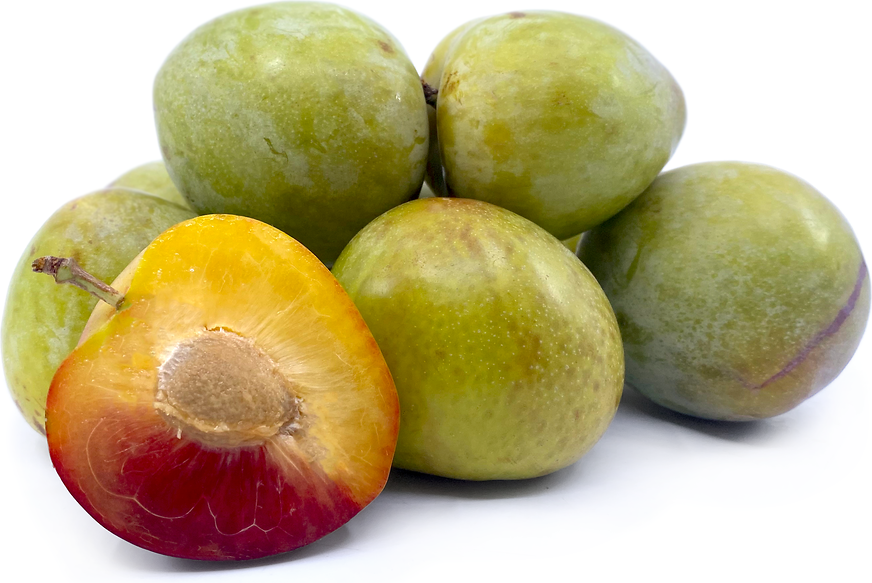


Broken Heart Plums
Estimated Inventory, cs : 0
Description/Taste
Broken Heart plums are small to medium fruits, averaging 4 to 5 centimeters in diameter, and have a uniform, round to cordate shape. The skin is smooth, semi-thick, taut, and firm with a green-yellow base, mottled with red striations and a gray bloom. The skin also features a prominent purple-red suture line that vertically extends the length of the fruit. Underneath the surface, the orange-yellow flesh is dense, aqueous, lightly fibrous, and semi-soft with a slight crunch, encasing a central, brown pit. The most defining characteristic of the variety is a splash of vibrant red pigment in the flesh of variable size and shape extending from the pit. It is important to note that each fruit varies in the amount of red coloring that appears in the flesh, and it is impossible to determine the shade from the outside. Broken Heart plums are aromatic with a subtly grassy scent and have a sweet-tart flavor, containing fruity, floral, and subtly tannic notes.
Seasons/Availability
Broken Heart plums are available for a limited season in the late summer.
Current Facts
Broken Heart plums, botanically a part of the Prunus genus, are a rare variety belonging to the Rosaceae family. The heart-shaped fruits were discovered growing as a spontaneous mutation on an elephant heart plum tree and were selected for their unique bi-colored flesh. Broken Heart plums are not commercially cultivated and are grown through specialty farms as a novel cultivar. The fruits are available for a short, limited season and are favored as a sweet-tart, fresh eating variety.
Nutritional Value
Broken Heart plums are a good source of vitamin C, an antioxidant that boosts collagen production within the skin, reduces inflammation, and strengthens the immune system. The plums also contain phytonutrients, natural chemicals with antioxidant-like properties to protect the body against free radicals and provide lower amounts of potassium, manganese, and copper.
Applications
Broken Heart plums are best suited for fresh preparations as the unusual flesh coloring, and sweet-tart flavor are showcased with consumed straight, out-of-hand. The fruits can be sliced and tossed into green salads, chopped and mixed into fruit bowls, or used as a fresh topping over oatmeal, porridge, and acai bowls. Broken Heart plums can also be pickled for extended use and served as a salty-sweet garnish and condiment, or they can be poached and served over ice cream and desserts. The firm fruits can be baked into sweet applications such as cobblers, pies, crumbles, and cakes, incorporated into a plum pudding, or simmered into jams, jellies, and chutney. They can also be grilled and served with roasted meats or caramelized and mixed into grain bowls or salads. Broken Heart plums pair well with meats such as lamb, pork, and duck, fish such as salmon, spices such as cardamom, cinnamon, cloves, and nutmeg, herbs such as basil, rosemary, and oregano, cheeses such as parmesan, halloumi, and goat, nuts such as pistachios, almonds, hazelnuts, and peanuts, honey, and black pepper. Whole Broken Heart plums will keep 3 to 5 days when stored in the crisper drawer of the refrigerator.
Ethnic/Cultural Info
Broken Heart plums earned their unusual name from grower Elsie Huerta. The fruit’s cordate shape and spotted, red-pigmented flesh is symbolic of a heart filled with blood, and Huerta reportedly named the variety in homage to her history of past love and broken hearts. The variety is also a descendant of the elephant heart plum, continuing the tradition of bearing “heart” in the name.
Geography/History
Broken Heart plums were discovered growing as a natural sport on an elephant heart plum tree in the fall of 1978. The sport was found in the orchard of Frank Vieira in Visalia, California, and Vieira spent several years grafting and cultivating the variety through the 1980s. Once the variety was successfully created, Vieira gave the rights of the fruits to close friend and grower Elsie Huerta as he was planning on retiring and wanted Huerta to continue the cultivation of the new variety. Huerta planted over five acres of Broken Heart plums in Tulare County, and today, Broken Heart plums are grown through home gardens and specialty farms for sale in local farmer’s markets within the United States.
Recipe Ideas
Recipes that include Broken Heart Plums. One
| The Kitchn |
|
Spiced Plum Jam |
| Bon Appetit |
|
Grilled Pork Chops with Plums, Halloumi, and Lemon |




